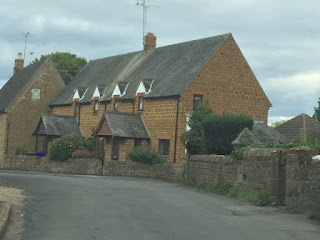But, of all the things I have learned over the past month, nothing compares to driving in England. On the opposite side of the road. On double and triple lane roundabouts. In a right handed drive car.
The driving on the opposite side of the road was the easy part as was driving to/from work. But, this past week, shit got real.
As some of you know, we got our start here with a bang. One day after arriving in England from Calais, a teen driver rear ended us while we were stopped at a light. Since we were flying home the following day for our home leave, we squared things away with our insurance to contact them when we returned.
 |
| Welcome to England... |
Last week, they picked the car up from our house and left us with a rental. I had no plans of driving this right handed drive, semi-automatic vehicle. But, with my better half very busy at work and my youngest starting after school activities, I had no choice.
My first day was the most harrowing of all. Driving a right hand drive car, when you have always driven a left hand drive, feels unnatural. I had to try to focus not only on staying in my lane, but also staying on the road and not brushing up alongside the hedges and trees lining the road and risking falling into a ditch. But that was the least of my problems.
I had to get my youngest at her first horse riding lesson. Nothing gives you more confidence than an email with directions from the school that says "entering the post code into your Sat Nav (GPS) will take you past the location." The Sat Nav is a way of life here. Every car has one because post codes is how you find an address. Google Maps and Waze that found the exact location without issue. The problem was getting there.
Why? Because you may be plodding along a normal road and then the directions take you onto a single track road. Read: off road. No I idea what I mean. Take a look:
 |
| Beautiful and horrifying at once! |
Did I mention that these roads have inclines and sharp turns? If you are driving uphill, you have no idea if anyone is coming down the the other end until you get over the hump or hit someone head on. We are in the middle of nowhere so there are no street lights. That said, I prefer driving at night because at least I can see if someone is coming via their headlights. Don't get me started on the one way stone bridges.
Then, we have the villages that dot the landscape. Lovely little places where every house looks like this:
 |
| Some look even lovelier with red ivy on their stone walls. |
But to get to this road, you have to make your way through this one:
 |
| A one lane road through the village. |
To deal with these things, they have something called a traffic easing measure which comes in two forms.
 |
| Traffic frustrating measure #1. |
When you see this on your side of the road, you have to stop and give way/yield to traffic from the opposite side. The other one is a sign pictured here:
 |
| Give way to oncoming traffic. |
This is a wonderful idea in principle considering that villages preceded roads and most roads are narrow one way roads. The problem is that sometimes you have the right of way and can't see the other traffic and they can't see you. It is a crapshoot that usually ends with one vehicle having to back up or pulling over if possible - there may be nowhere to pull over when you are stuck between two stone buildings. The nice thing is that in these circumstances, drivers are very patient and more often than not, they let you pass and wave at you.
But it all leads to a muscle tensing wild ride. I overheard my daughter telling my husband "You should have seen mom today when the Tesco truck kept driving at her on the one lane road. She kept saying "Really Tesco, really?" She thinks its real funny.
But nothing is more horrifying than encountering a double or triple lane roundabout. This infographic from Gov.uk says it all:
 |
| Take a look at the green and blue cars at your bottom left. |
Sometimes the road you need to get on is listed in one of the lanes and you just queue and look right before entering. But sometimes there is no guidance. Last week, after taking a deep breath and doing the sign of the cross, I went in and came out the other end. Roundabouts are a blessing and a curse. What I have realized is that because there are so few traffic lights, traffic keeps moving. This is great, but exhausting. If you are driving for an hour, for example, you have no breaks. You are driving non stop which makes trips of more than a few hours pretty tiring.
I dread the day I come upon the Magic Roundabout pictured here:
 |
| https://en.wikipedia.org/wiki/Magic_Roundabout_(Swindon) |
There is a reason why the Satanic cult symbol (and coincidentally, the Pentagon) is the pentagram. Those are five circles of hell that I don't ever want to encounter.
In case you are wondering, the village and single track road pics were taken while I was a passenger in the vehicle since you are not allowed to eat, drink coffee, or anything else deemed to be distracting while driving. And that is probably the best thing about driving here.
